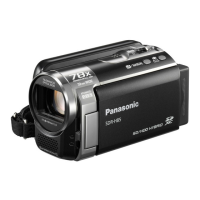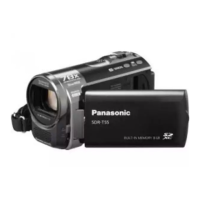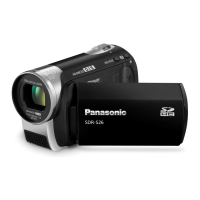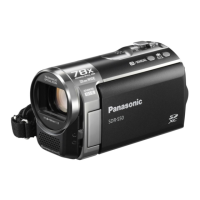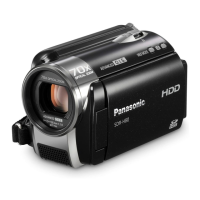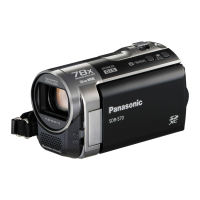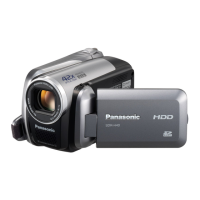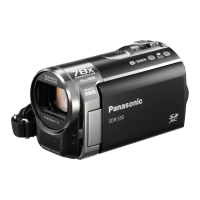Why the battery of my Panasonic SDR-SW20 RED is swollen?
- FFelicia BrownSep 12, 2025
If the lithium ion battery used with your Panasonic Camcorder swells, it may be due to frequent charging/discharging. However, this poses no safety risk.
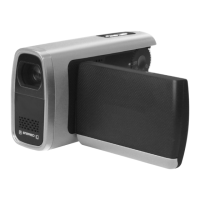
Why the battery of my Panasonic SDR-SW20 RED is swollen?
If the lithium ion battery used with your Panasonic Camcorder swells, it may be due to frequent charging/discharging. However, this poses no safety risk.
What to do if error message appears on Panasonic Camcorder LCD monitor?
If an error message appears on the LCD monitor of your Panasonic Camcorder, eject the SD card and set the mode dial to [OFF] to protect data. The unit will turn off after about 1 minute.
Instructions for replacing the fuse in the AC mains plug, including regional variations.
Advice on using recommended accessories and EMC compatibility information.
Warnings to prevent fire, electric shock, damage, overheating, and battery issues.
Precautions regarding ventilation, obstructions, naked flames, and battery disposal.
Notes on recording content indemnity, copyright, temperature, and LCD monitor behavior.
Warning that the built-in lithium battery must only be replaced by qualified personnel.
Details the unit's IP58 rating, limitations, and user mishandling exclusion.
How to use the unit underwater, including depth, duration, and safety precautions.
Instructions for cleaning and drying the unit after underwater exposure.
Precautions against impact, temperature, wet hands, and cleaning lens/mic.
Recommends replacing water-resistant packing every 18 months.
Instructions for opening and closing the card/battery door and terminal cover.
Instructions for attaching and using the 2-way hand strap.
How to open and adjust the angle of the LCD monitor.
Contact details for customer care and technical support.
Information on ordering accessories and products via phone or website.
List of optional accessories available for purchase.
Lists compatible SD and SDHC memory card types and capacities.
Lists specific recommended Panasonic SD/SDHC memory card models.
Precautions for handling, storing, and preventing damage to SD cards.
Explanation of the write-protect switch on SD cards and its effect.
Step-by-step instructions for inserting the battery and connecting the AC adaptor to charge.
Explains the status indicator lights during charging and troubleshooting tips.
Estimates for charging time and recording duration based on battery and conditions.
How the battery indicator on the LCD shows remaining power.
Step-by-step guide for inserting and removing SD cards safely.
Explains the card access lamp and operations to avoid during access.
How to turn the unit ON/OFF and select recording/playback modes using the dial.
Using the LCD monitor to turn the unit ON/OFF.
How the quick start feature enables faster shooting.
Instructions on how to enable or disable the quick start function via menus.
Guide to accessing and navigating through the camera's menu system.
How to change the language displayed on the camera's LCD screen.
Procedure for setting the camera's date and time.
How to choose the format for displaying the date.
How to adjust the LCD monitor's brightness and color density.
Using the Power LCD feature for better visibility in bright conditions.
Tips on holding the camera for stable recordings.
How to activate underwater mode and related precautions.
Default mode with automatic settings for focus, coloring, and brightness.
Mode for manually adjusting focus, white balance, shutter speed, etc.
Warning against operations during SD card access to prevent data damage.
Step-by-step guide to start and stop motion picture recording.
How to change the aspect ratio from 16:9 to 4:3.
Explanation of XP, SP, and LP recording modes and their quality.
Table showing approximate recording times based on SD card capacity and mode.
How to select different recording modes via the menu.
Step-by-step guide for taking still pictures automatically.
How to disable shutter sound and on-screen display.
Explanation of High and Standard picture quality settings and storage capacity.
How to adjust picture quality via the menu.
Tips for stabilizing the image, especially when zooming.
How to use optical zoom up to 10x and digital zoom up to 700x.
Explains the image stabilizer feature for reducing jitter.
Using the zoom microphone feature for enhanced audio recording.
How auto slow shutter improves brightness in dark locations.
Guide to displaying and changing operation icons for various functions.
How to use the fade effect for smooth video transitions.
Adjusting exposure for subjects against bright backgrounds.
Using the self-timer for still picture capture.
Feature to soften skin tones in portraits.
Enhancing colour visibility in low-light conditions.
How to switch to manual recording mode.
Procedure for manually focusing the subject.
Using pre-set modes like Sports, Portrait, Low Light, etc.
Adjusting white balance for accurate colors under different lighting.
How to adjust shutter speed for capturing motion.
Adjusting iris and gain for proper exposure.
Setting travel destination time for accurate recording dates.
Displaying composition guides on the LCD for better framing.
Reducing wind noise picked up by the microphone.
How to select and play motion pictures from the thumbnail list.
Explains fast-forward, rewind, slow-motion, and frame-by-frame playback.
How to resume playback from where it was interrupted.
How to select and view still pictures.
Controls for slideshow playback and navigating between still pictures.
Procedure for deleting one picture at a time.
How to select and delete multiple pictures or all pictures.
How to lock pictures to prevent them from being deleted accidentally.
Instructions for formatting SD cards, including data loss warnings.
How to select pictures and set print quantities for DPOF.
How to cancel all DPOF settings.
Steps for connecting the camera to a TV for viewing recorded content.
How to control the display of camera information on the TV screen.
How to copy footage to recorders using an AV cable.
How to copy footage to DVD recorders using an SD card slot.
Connecting the camera directly to a PictBridge printer for printing.
Adjusting print settings like date, paper size, and layout.
Lists required equipment and supported disc types for DVD burning.
Steps for connecting the camera and a DVD burner using a USB cable.
How to copy still pictures to discs using the DVD burner.
How to copy all or selected motion pictures to discs.
Details on MotionSD STUDIO video editing software and DirectX.
Step-by-step instructions for installing the MotionSD STUDIO software.
How to import and edit motion and still pictures using the software.
Instructions for properly closing the MotionSD STUDIO application.
How to connect the unit to a computer as an external drive.
Steps for safely disconnecting the unit from the computer.
Explains the file and folder structure on the SD card.
Steps to check the device manager for connection and driver status.
Methods to resolve issues when the unit is not recognized by the computer.
Required operating environment for connecting to Macintosh computers.
Instructions for connecting and copying files to a Macintosh computer.
Lists and explains menu items related to recording settings.
Lists and explains menu items related to playback settings.
Lists and explains menu items for general system configuration.
Explains the indicators shown on the LCD during recording.
Explains the indicators shown on the LCD during playback.
Lists common messages and their troubleshooting steps.
Lists common operational problems and solutions.
Precautions regarding electromagnetic interference, cell phones, impact, and storage.
Guidelines for battery and SD card care to ensure longevity and performance.
Cautions for using and maintaining the AC adaptor and LCD monitor.
Precautions for condensation, cleaning procedures, and shock resistance.
Detailed specifications for the camera, lens, zoom, and monitor.
Specifications for recording media, compression, and picture sizes.
Specifications for the AC adaptor and battery pack.


